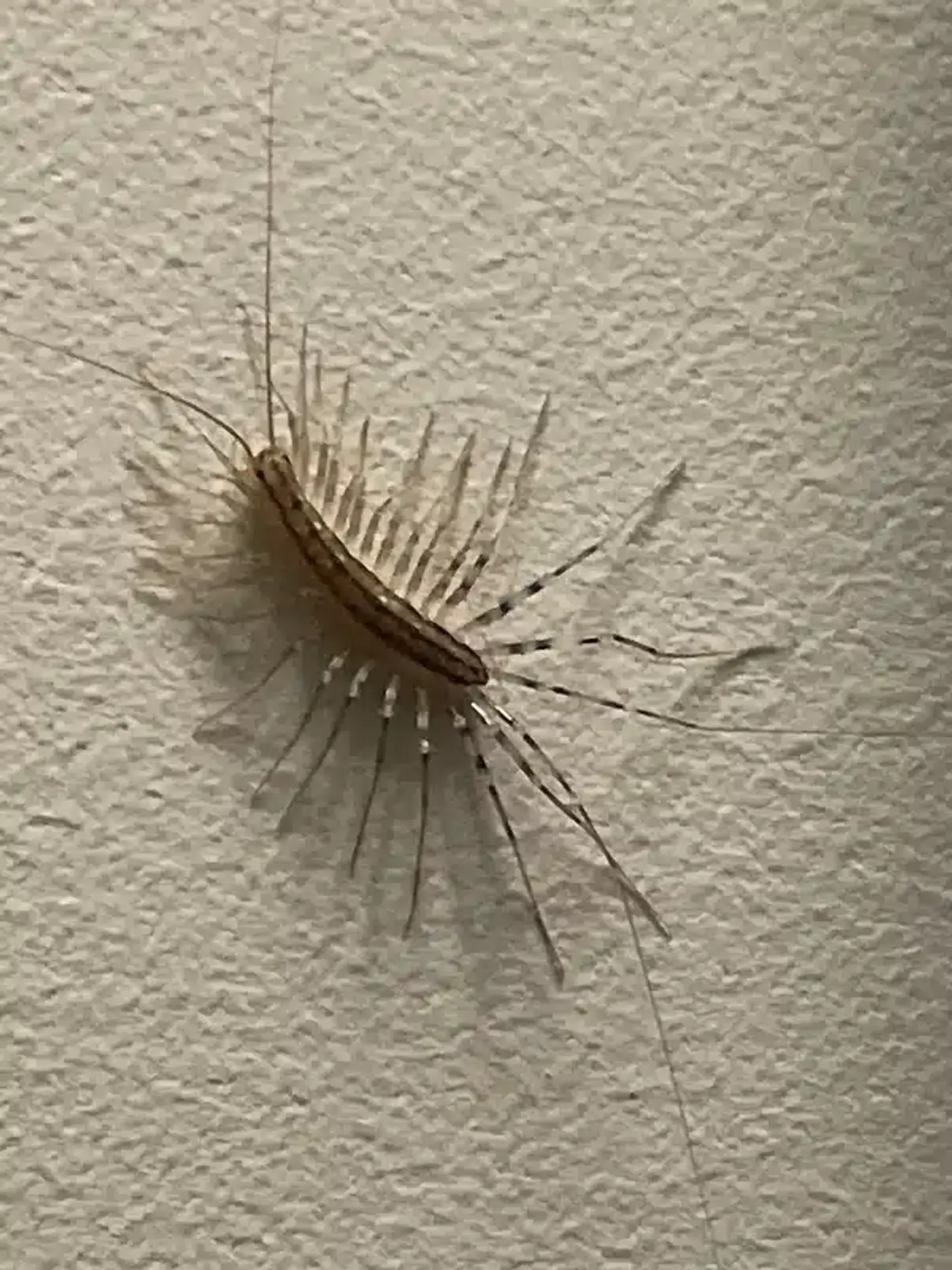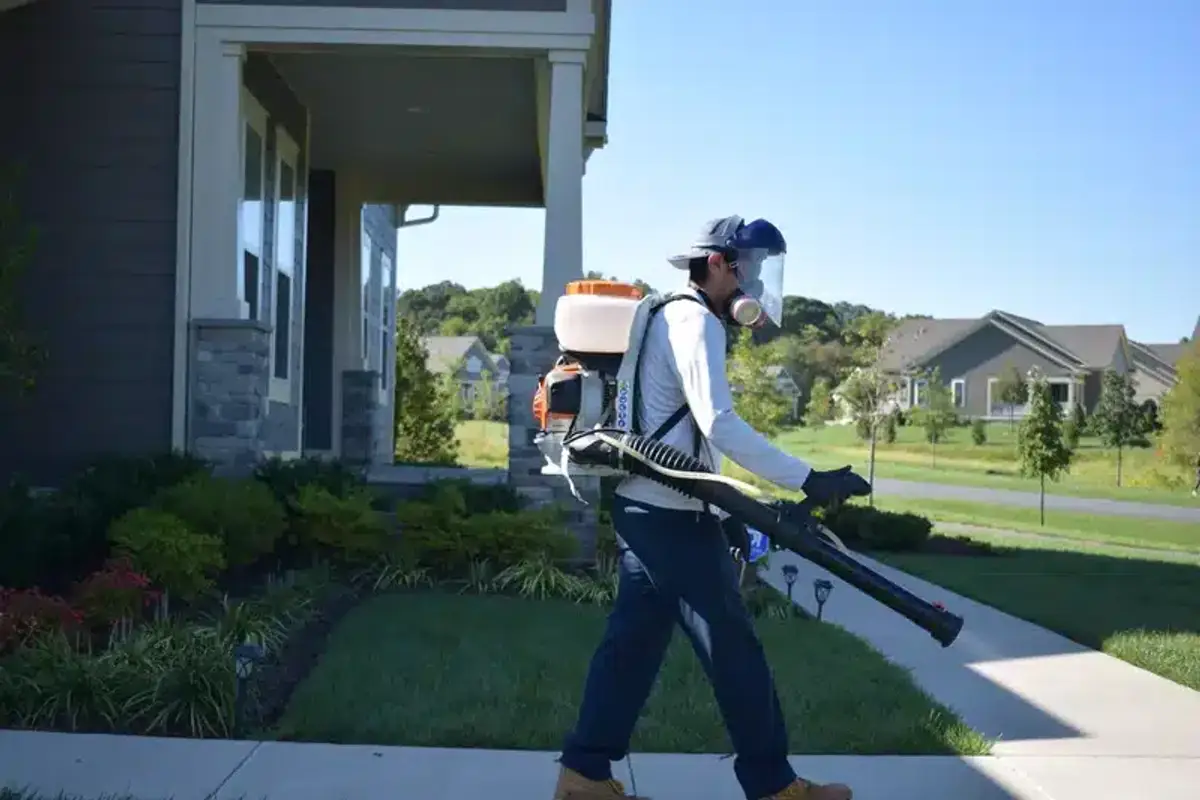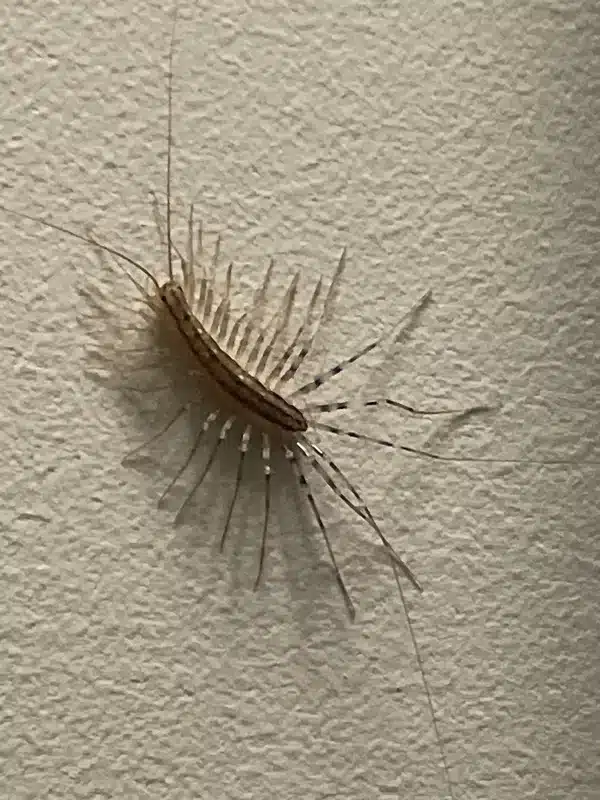Finding centipedes scurrying across your bathroom floor at 2 AM can be startling. These many-legged creatures seem to appear out of nowhere, especially during humid summer months here in the DMV area. While they might look scary with their long legs and quick movements, centipedes are actually hunters that feed on other household pests.
After working as a registered technician in the pest control industry for several years, I’ve helped countless homeowners understand why centipedes show up indoors. The good news is that getting rid of centipedes is totally manageable when you understand what draws them inside and take the right steps to address those conditions.

Understanding House Centipedes: What You’re Dealing With
Before diving into how to get rid of centipedes, it helps to know what you’re up against. Centipedes belong to the class Chilopoda and have one pair of legs per body segment. They’re predators that hunt silverfish, cockroaches, spiders, and other household insects.
The most important thing to understand is that centipedes are moisture-loving creatures. Their breathing system requires high humidity to function properly, which is why you’ll typically find them in basements, bathrooms, and other damp areas of your home.
House Centipedes vs. Other Species
In the Virginia, Maryland, and DC area, you’re most likely dealing with the house centipede (Scutigera coleoptrata). These creatures have 15 pairs of very long, banded legs and can actually complete their entire life cycle indoors. They’re the only centipede species that truly thrives inside homes.
Other centipedes you might encounter include stone centipedes and bark centipedes, but these typically wander in temporarily from outdoor hiding spots. Only house centipedes establish breeding populations indoors.

Why Centipedes Invade Your Home
Understanding why centipedes show up is crucial for getting rid of them effectively. In our family business, we’ve been serving the DMV area for over 50 years, and I’ve noticed that centipede complaints usually spike during certain conditions.
Moisture Problems
The biggest reason centipedes enter homes is excess moisture. When indoor humidity stays above 50%, or when there are leaks and condensation issues, you’re creating the perfect environment for these pests. Basements with poor ventilation are especially problematic.
Available Food Sources
Centipedes follow their food. If you have silverfish, cockroaches, or spiders in your home, centipedes will hunt them down. This is why addressing your overall pest situation is important when learning how to get rid of centipedes.
Seasonal Factors
Autumn cooling and midsummer droughts drive centipedes toward the comfortable conditions inside your home. Additionally, outdoor harborages like leaf piles and mulch beds right against your foundation act as stepping stones that make indoor invasion easier.
Moisture Control: Your First Line of Defense Against Centipedes
The most effective way to get rid of centipedes starts with controlling moisture. This addresses the root cause rather than just treating symptoms.
Indoor Moisture Solutions
Start by fixing any plumbing leaks and insulating cold-water pipes that sweat during humid weather. Run bathroom exhaust fans for at least 20 minutes after showers, and make sure they vent outdoors rather than into your attic.
Maintain indoor humidity between 30-50% using dehumidifiers, especially in basements and crawl spaces. Proper humidity management prevents many pest problems besides centipedes.
What does the science say?
According to the EPA’s moisture control guidance, maintaining indoor relative humidity between 30-50% is critical for preventing arthropod pest problems. The EPA specifically notes that humidity levels above 50% create favorable conditions for house-infesting pests, including centipedes, which require high moisture environments for survival.
Research from the Virginia Cooperative Extension confirms that only house centipedes (Scutigera coleoptrata) can complete their entire life cycle indoors, making moisture control particularly effective against this species. Their respiratory system requires high humidity to function, making dehumidification a scientifically-backed control method.
Exterior Drainage Improvements
Grade soil so it slopes away from your foundation for at least 10 feet. Extend downspouts well away from the house and keep gutters clean. These steps prevent water from pooling near your foundation where centipedes like to hide.
Create a 3-foot plant-free zone around your home’s perimeter. Replace wood mulch with gravel or stone, which stays drier and provides fewer hiding spots for centipedes and their prey.
Sealing Entry Points
While moisture control tackles the main attraction, sealing entry points prevents centipedes from getting inside in the first place. Focus on the most common problem areas in Mid-Atlantic homes.
Priority Areas for Sealing
Check around basement windows, utility penetrations, and door thresholds. The junction where your rim joist meets the sill plate is often overlooked but provides highway access for centipedes and other pests.
Use high-quality exterior caulk for cracks smaller than 6mm and low-expansion foam for larger gaps. Install brush-type door sweeps and make sure foundation vents have 20-mesh screens.
The Department of Energy’s air sealing guidelines provide excellent techniques that work for pest exclusion while also improving your home’s energy efficiency.
Natural Methods to Get Rid of House Centipedes
Once you’ve addressed moisture and entry points, several low-risk treatment options can help eliminate remaining centipedes without harsh chemicals.
Desiccant Dusts
Diatomaceous earth and silica gel dusts work by drying out centipedes when they crawl through treated areas. Apply thin films in wall voids, around sill plates, and in pipe chases. These materials stay effective even in slightly damp conditions.
Physical Removal
Vacuum up centipedes when you see them. They actually desiccate quickly indoors when humidity drops below 40%. Sticky insect monitors along baseboards help you identify activity hot spots while also catching centipedes.
Habitat Modification
Remove leaf litter, grass thatch, and decorative timbers from around your foundation. Keep shrub canopies pruned at least 12 inches from your walls. These changes eliminate outdoor harborages that support centipede populations.
Treatment Method Comparison
| Natural Methods | Chemical Treatments | |
|---|---|---|
| Speed of Results | 2-4 weeks | 1-2 weeks |
| Safety Level | Very safe | Requires precautions |
| Long-term Effectiveness | Excellent (addresses root cause) | Temporary without moisture control |
| Best For | Prevention & long-term control | Heavy infestations |

Chemical Treatment Options
For persistent centipede problems, targeted chemical treatments can provide additional control when used alongside moisture management and exclusion.
Crack and Crevice Applications
Boric acid dust applied to wall voids and entry points provides long-term control. This material has low toxicity to mammals while being effective against centipedes. Always follow label directions and keep treatments away from areas accessible to children and pets.
Perimeter Treatments
Homeowner-label pyrethroids like cyfluthrin or deltamethrin can be applied around your home’s exterior perimeter. Focus on areas where centipedes are active rather than broadcasting over large areas.
Remember that chemical treatments alone provide only temporary relief. You must combine them with moisture control and exclusion for lasting results. Similar integrated approaches work well for other household pests that share centipedes’ preferences for damp conditions.
Safety First
Always follow label directions exactly when using chemical treatments. Focus on targeted applications in specific problem areas rather than broad spraying, and ensure children and pets are kept away from treated areas until surfaces are completely dry.
Professional Centipede Pest Control Services
Sometimes the best approach to getting rid of centipedes involves calling in professionals, especially when dealing with recurring problems or hard-to-reach areas.
When to Call a Professional
Consider professional help when you continue seeing centipedes after addressing moisture and entry points, or when infestations involve inaccessible areas like crawl space voids. Additionally, if you’re finding larger species like bark centipedes indoors, professional identification and treatment becomes more important.
What to Expect from Professional Service
At Better Termite & Pest Control, our registered technicians start with a thorough inspection to identify moisture sources, entry points, and centipede activity areas. We’ve removed 9 of the industry’s harshest chemicals from our treatment options, focusing on products we’d feel comfortable using in our own homes.
Our approach includes interior treatment of baseboards and active areas, exterior perimeter applications, and detailed recommendations for moisture control and exclusion. We also provide ongoing monitoring to ensure long-term success.
50+ Years of Centipede Control in Northern Virginia
Working as a registered technician in our family pest control business, I’ve noticed clear patterns in centipede complaints across the DMV area. Our five decades of service have taught us that successful centipede control requires understanding local conditions.
- Arlington & Alexandria: Older homes with foundation moisture issues are most problematic
- Brambleton & newer developments: Construction activity disturbs ecosystems, driving pests indoors
- Areas near waterways: Properties near poor drainage require extra moisture management attention
- Seasonal patterns: Complaints spike during humid summers and when autumn cooling drives centipedes inside
This regional expertise allows us to tailor treatment approaches based on specific local challenges, leading to more effective long-term control.
How to Prevent Centipedes: Keeping Them Away Long-Term
The best strategy for dealing with centipedes is preventing them from becoming a problem in the first place. Focus on making your home less attractive to these moisture-loving predators.
Essential Centipede Prevention Steps
- Moisture Control: Maintain indoor humidity below 50%, fix plumbing leaks promptly, and ensure proper ventilation in basements and crawl spaces
- Entry Point Sealing: Caulk cracks around basement windows, utility penetrations, and door thresholds with high-quality exterior sealant
- Outdoor Management: Keep a 3-foot plant-free zone around your foundation and replace wood mulch with gravel or stone
- Regular Maintenance: Clean gutters twice yearly, inspect for new moisture sources, and monitor humidity levels in problem areas
Ongoing Moisture Management
Check and maintain your moisture control systems regularly. Clean gutters twice yearly, inspect for new leaks, and monitor basement humidity levels. Consider it preventive maintenance that protects against multiple pest problems.
Seasonal Maintenance
Before autumn arrives, remove leaf litter from around your foundation and check door seals and window caulking. Stack firewood well away from your house and inspect it before bringing pieces indoors.
Spring is an excellent time to review your exterior drainage and make improvements before summer humidity peaks. These same practices help prevent other moisture-loving pests like termites and silverfish.
Understanding Treatment Limitations
It’s important to have realistic expectations when learning how to get rid of centipedes. These creatures are excellent at finding tiny entry points and moisture sources that might not be obvious to homeowners.
Complete elimination might take several weeks to months, especially if you’re dealing with established populations. The key is persistence with moisture control, exclusion, and appropriate treatments rather than expecting instant results from sprays alone.
Remember that finding an occasional centipede doesn’t necessarily indicate a major infestation. These solitary hunters often wander in from outdoor areas and may not represent a breeding population inside your home.
Safety Considerations
When using any pest control products, prioritize the wellbeing of your family and pets. Read all labels completely and follow application instructions exactly. Store pesticides in locked cabinets away from children.
Avoid applying dust treatments near HVAC returns where particles could become airborne. When treating with sprays, wait for surfaces to dry completely before allowing children and pets back into treated areas.
All products we use at Better Termite & Pest Control are EPA-approved and have passed through our internal research team’s evaluation. Each one is a product we’d feel comfortable using in our own homes.
Regional Considerations for the DMV Area
Living in Virginia, Maryland, or DC brings specific challenges for centipede control. Our humid summers and varied housing stock create ideal conditions for these pests.
Older homes in areas like Arlington and Alexandria often have foundation moisture issues that attract centipedes. Newer developments in places like Brambleton face different challenges, where construction activity disturbs the ecosystem and drives pests indoors.
Areas near waterways or with poor drainage, such as parts of Dumfries, may require extra attention to exterior moisture management. Local pest control professionals understand these regional factors and can tailor treatments accordingly.
Getting rid of centipedes successfully requires a comprehensive approach that addresses the reasons they’re attracted to your home. By controlling moisture, sealing entry points, and using appropriate treatments, you can eliminate these unwelcome visitors and prevent their return.
If you’re dealing with persistent centipede problems or need help identifying moisture sources and entry points, don’t hesitate to reach out for professional assistance. Call us at 703-683-2000 or email info@bettertermite.com for expert guidance tailored to your specific situation.
Frequently Asked Questions
How do I get rid of centipedes naturally?
+
The most effective natural method is controlling moisture levels in your home. Use dehumidifiers to keep humidity below 50%, fix leaks, and improve ventilation. You can also apply diatomaceous earth in areas where centipedes travel, vacuum them when you see them, and remove outdoor debris near your foundation that provides hiding spots.
Why do I keep finding centipedes in my bathroom?
+
Bathrooms provide the high humidity that centipedes need to survive. Steam from showers, poor ventilation, and potential plumbing leaks create ideal conditions. Run exhaust fans for 20 minutes after showers, check for leaks around tubs and sinks, and consider using a small dehumidifier if the problem persists.
Are centipedes dangerous to humans?
+
House centipedes can bite but rarely penetrate human skin. Even when they do bite, the pain is comparable to a wasp sting with minimal health risk. They're actually beneficial predators that hunt cockroaches, silverfish, and spiders. The main issue is that many people find them alarming to encounter.
What attracts centipedes to my house?
+
Centipedes are attracted by moisture and food sources. High humidity, water leaks, condensation, and poor ventilation create the damp conditions they need. They also follow their prey, so if you have silverfish, cockroaches, or spiders, centipedes will hunt them indoors. Outdoor debris like leaf piles near your foundation also provides staging areas.
How long does it take to get rid of centipedes?
+
Eliminating centipedes typically takes several weeks to months, depending on the severity of moisture problems and size of the population. You should see reduced activity within 2-4 weeks after addressing moisture issues and sealing entry points. Complete elimination requires persistence with environmental modifications rather than relying solely on pesticide applications.
Should I use pesticide sprays to kill centipedes?
+
Pesticide sprays alone provide only temporary relief because they don't address why centipedes are in your home. Focus first on moisture control and sealing entry points. If you do use sprays, apply them to specific areas where centipedes travel rather than broadcasting over large surfaces, and always combine with environmental modifications for lasting results.
Can centipedes live and breed inside my house?
+
House centipedes (Scutigera coleoptrata) are the only species that can complete their entire life cycle indoors. Other centipede species typically wander in from outdoor areas temporarily. If you're seeing centipedes regularly, you likely have house centipedes that have established a breeding population due to favorable moisture and food conditions.
Do centipedes come up through drains?
+
While centipedes prefer moist areas, they don't typically travel through water-filled drain traps. They're more likely entering through cracks around the drain area, gaps in caulking, or other entry points near plumbing fixtures. Check and reseal caulk around tubs, sinks, and shower bases to eliminate these access points.
When should I call a professional for centipede control?
+
Call a professional if centipedes keep showing up after you've addressed moisture control and entry points, especially when activity persists in crawl spaces or larger species like bark centipedes start appearing indoors.
With five years of hands-on experience in the pest control industry, George Schulz is a registered technician with the Virginia Pest Management Association and a proud third-generation professional in a family business that's been protecting homes for over 57 years. He manages and trains a team of service pros while also leading internal research efforts—recently spearheading a deep-dive review of thousands of documents on pest control materials to hand-pick the most kid and pet friendly, most effective solutions tailored specifically for homes in the DC metro area.
